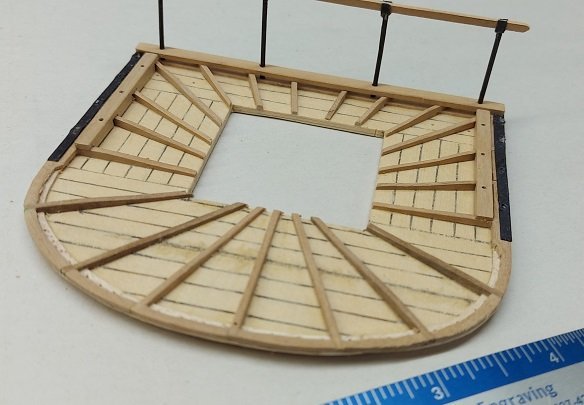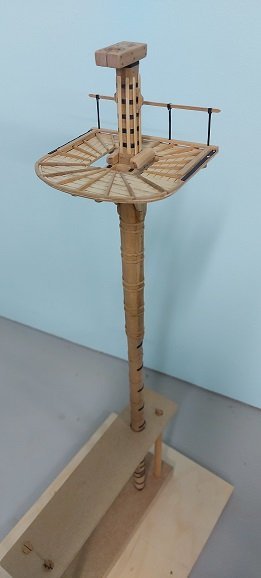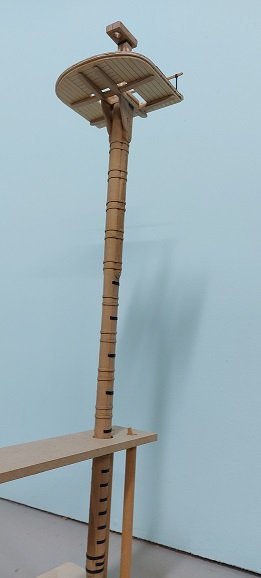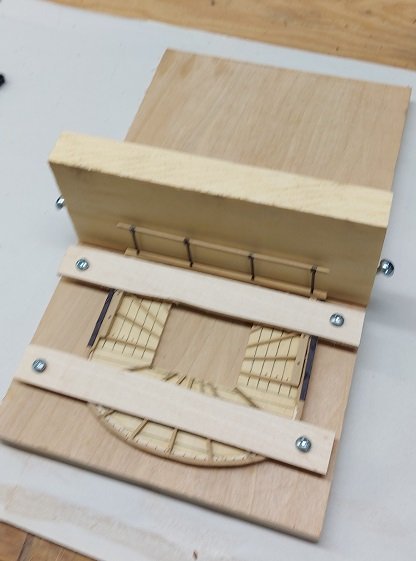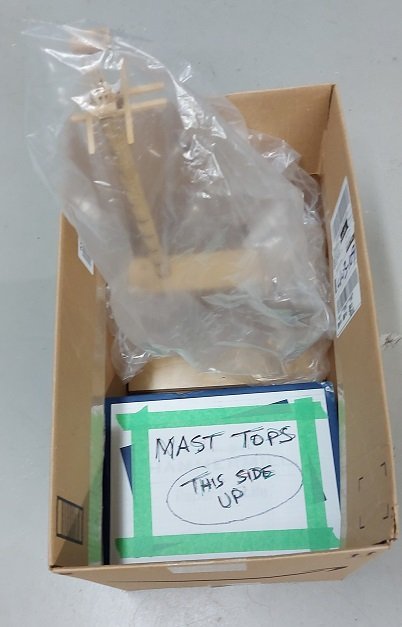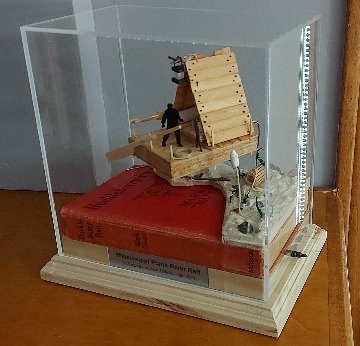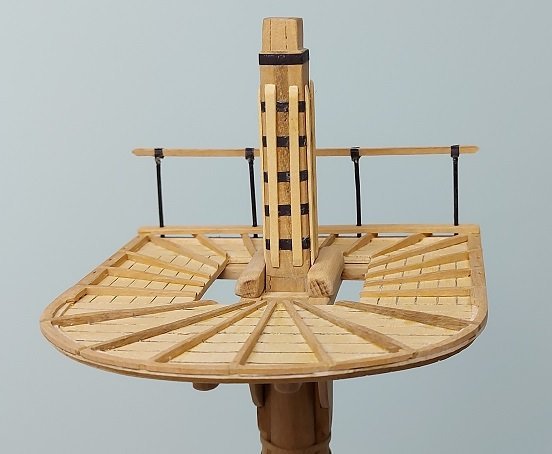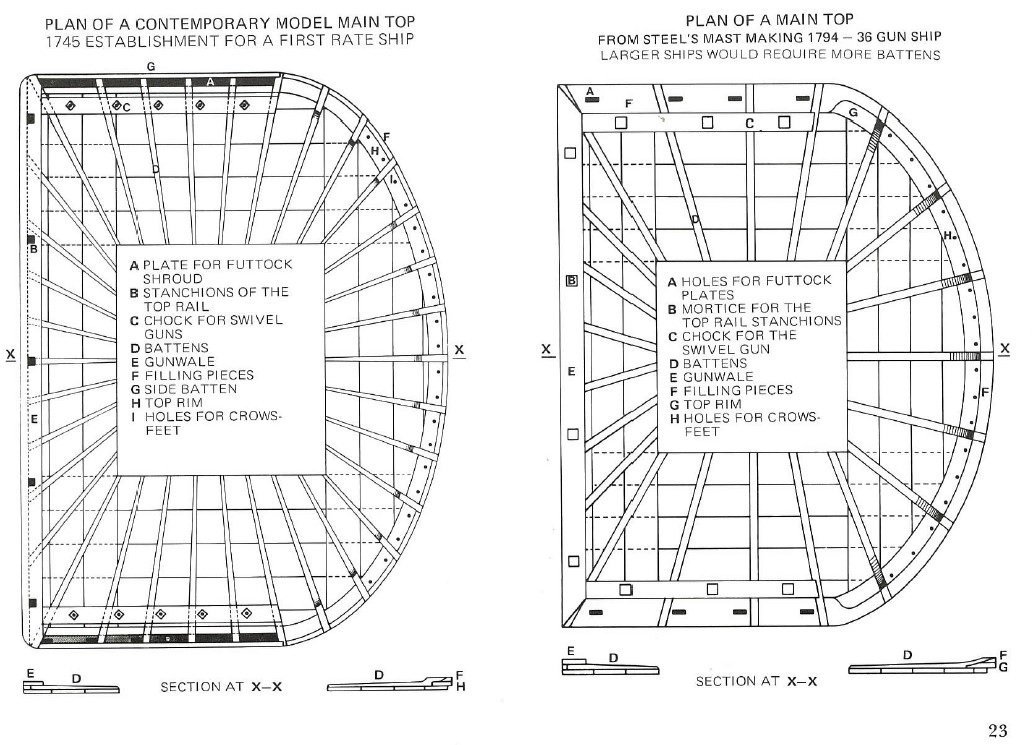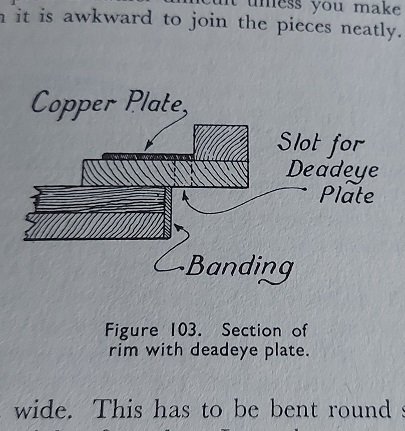-
Posts
2,841 -
Joined
-
Last visited
Content Type
Profiles
Forums
Gallery
Events
Everything posted by AON
-
I added the iron bars to the outside of the main top for the deadeye shrouds. This are blackened card stock. I added the swivel gun chocks inboard of the above and drilled the six holes for the swivel gun posts. I needed to determine the height of the swivel gun chocks. The hidden lines in the drawing tells me the radial top battens pass through it, that it is taller then them. I decided to make them the same height as the gunwale plank below the handrail stanchions. Below are a few photos. The top is not secured to the trees as a number of blocks need to be added and they might be easier to do with it separated. So I stow the mast in a rack in a box with dust protection, and the mast top clamped to a piece of wood (keeping it flat and safe) with a guard for the handrail... in a box, and then this in the box with the mast rack. It will be awhile before they are mounted so I need to keep them off to one side. Now I go back to my last few frames.
-
After considerable research, finding most reference books disagree with each other and some presenting juxtaposed information within themselves, finding only one recent reference to the metal band in the NMM/RMG collection, finding no mention of swivel guns in any Bellerophon newspaper reports of the day, finding several images of different styles of swivel guns for the period in the NMM/RMG collection, finding a reference to an order to stop the practice of arming HM Ships with swivel guns a decade after 1786, and realizing copper would corrode (galvanic reaction) with the iron of the deadeye strap.... I've decided to install the wooden swivel gun chocks and add the blackened iron metal bars along the outsides as one length per side as in my mind the original as launched build would have likely had them whether they were used or not. Hope to have this done after I've finished the base for my Aleutian Hunting Kayak which I am in the middle of completing. Late last week I completed the base for my Mississippi Plank River Raft as can be seen below.
-
Now I know how I might apply the name on the transom of my build (a few years from now). Thanks!
- 321 replies
-
- Finished
- Flower-class
-
(and 1 more)
Tagged with:
-
Wish I could offer some advice about stenciling but I suppose that will be one more thing I'm about to learn.
- 321 replies
-
- Finished
- Flower-class
-
(and 1 more)
Tagged with:
-
The late 1700's saw a lot of changes, like the woolding ropes/hoops being replaced with iron hoops, various developments in the dolphin striker. Your rudder bolt heads look wonderful... thanks go to John Cairns of our local club for having shared this method with us. Those plastic build guys can do amazing things!
- 366 replies
-
- bellerophon
- victory models
-
(and 2 more)
Tagged with:
-
I recently had to do the same thing for my 3D program. Why can't they leave well enough alone?
- 321 replies
-
- Finished
- Flower-class
-
(and 1 more)
Tagged with:
-
Sorry to hijack this build but I've one question. Why does a raft adhere when a brim or just the object doesn't?
- 321 replies
-
- Finished
- Flower-class
-
(and 1 more)
Tagged with:
-
I am not sure how your printer feeds but I have the same issue. I level the bed 3 times after it has been allowed to warm up and soak at temperature and noticed no matter what I do the centre is perfect and the corners are tight or the corners are perfect and the centre is loose (concaved glass?). And I clean it before every use. I tried printing off centre. Tried a brim. The only thing that consistantly works for me is a raft. Also, occassionally I need to disassemble the feeder and clean the gear teeth as it gets clogged with filament and then starts skipping.
- 321 replies
-
- Finished
- Flower-class
-
(and 1 more)
Tagged with:
-
I am not sure why, as I can see 5 people liked the last post, but I cannot open the link I get a "cannot find" message.
- 1,103 replies
-
I think the unusual pic without the lug dipped is because the cox'n has no crew to do it and he cannot leave the tiller unattended.
-
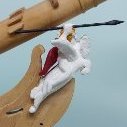
finishing 1786 British main mast top (platform) deadeye shroud slots
AON replied to AON's topic in Masting, rigging and sails
One afternoon of searching revealed only one item with any detail. Not really a primary source as it is a model of masts and yards on a display board, dated as being displayed at an exhibition in 1938. If you zoom in on any of the three tops you can see the bar with the slotted holes through it. There is no swivel gun chock though. https://collections.rmg.co.uk/collections/objects/68788.html I'll keep looking. -
When I was a teen (1969-70) the lug rigged boats were set with a rope/bullseye type fitting that dropped onto a traveller hook that was raised up and down on the mast. Just a short portion protruded forward of the mast. When we tacked it was one fellows job to dip the lug to the other side of the mast. I'll see if I have any photos. I should have mentioned the traveller was a leather covered metal hoop with a hook. A halyard was used to raise/lower it. update: photos I have are too far away, or the traveller is too high (out of frame). sorry.
-

finishing 1786 British main mast top (platform) deadeye shroud slots
AON replied to AON's topic in Masting, rigging and sails
Notes to myself FACT: So the most convincing argument against a copper plate is the galvanic (corrosion) reaction that would occur between the iron deadeye strap in contact with the copper. OPINION: In Mr. Longridge's Anatomy of Nelson's Ships book: he may have suggested copper but failed to mentioned it would be blackened to simulate iron. OPINION: In Mr. Lees' Masting and Rigging book: The iron plate was not individual pads between the stiffening battens, but was one long plate running under the stiffening battens in the early version of the top construction (1745) , and over top in later version (1794) of top construction. Worth noting: It was not shown in the 36 gun version, but then they are shown again in figures for 1802-1815 and 1815-1833 which are not attributed to any specific size of ship. I will continue my search for any definitive primary source. I am also intrigued by the swivel gun chocks and have been looking into those. -

finishing 1786 British main mast top (platform) deadeye shroud slots
AON replied to AON's topic in Masting, rigging and sails
so people can see what I'm looking at My main mast top... below is The Anatomy of Nelson's Ships, pg 173, fig 103... below is The Masting and Rigging of English Ships of War, pg 23... -
What slicer program are you using? Does it allow you to make adjustments to the settings? Not suggesting you should since everything is printing tickedy-boo right now, without errors (knock on wood)... just curious.
- 321 replies
-
- Finished
- Flower-class
-
(and 1 more)
Tagged with:
-
I believe the new RN aircraft carrier HMS Queen Elizabeth (1) was built that way also.
- 321 replies
-
- Finished
- Flower-class
-
(and 1 more)
Tagged with:
-
I can imagine the satisfaction of realising the fit while assembling these pieces. Can you please hurry up so I can see the whole thing! 😇 😁
- 321 replies
-
- Finished
- Flower-class
-
(and 1 more)
Tagged with:
-

finishing 1786 British main mast top (platform) deadeye shroud slots
AON replied to AON's topic in Masting, rigging and sails
But are they truly in balance? I've seen shrouds on cutters slack slightly on the leeside so can imagine deadeyes wearing a pocket in a wooden filler piece. The soft brass plate seems a good bearing or wear surface. Why would one source specify them in the larger ships and another suggest something was there? I wonder about these things 🤔 -

finishing 1786 British main mast top (platform) deadeye shroud slots
AON replied to AON's topic in Masting, rigging and sails
Thank you Druxey Yes that is correct. Yet The Anatomy of Nelson's Ships page 173, Figure 103 shows it as a copper deadeye plate with the slots for the deadeye through it. The write up (2nd paragraph from the bottom) reads as if it is two long plates at one per side. The Masting and Rigging of English Ships of War on page 23 shows for a 1st rate, 1745, a darkened "A" - "plate for the futtock shroud". The accompanying figure, 1794, 36 gun ship, shows no plate. Page 24, 1802 to 1815, no ship specified, shows "A" - "plate for the futtock shroud". and the accompanying figure for 1815 to 1833 shows "J" - "plate for the futtock shroud". There is no written description for it. Might I also point out Steels plate 2 shows 13 woolding hoops for the main mast, whereas plate 3 shows only 10 for the exact same mast. The written description calls up 6 bolts to connect the two halves of the main mast cap but the image on plate 2 shows 8 It is difficult to find sources that agree with each other, or even themselves! I am beginning to think I may need to "wing it". -
My scratch build doesn't fair that well. Nice job!
- 321 replies
-
- Finished
- Flower-class
-
(and 1 more)
Tagged with:
-
I am building a British 3rd rate MOW, launch date 1786, and am trying to represent her as launched. At this point I am working on my main mast top (platform) and am looking at the small details. I am confused by the fact many sources do not agree. Even Steels reads one thing, then presents images that do not agree with the written description or the other view! The Anatomy of Nelsons Ships does likewise. Can anyone tell me if there were in fact 1) individual copper plates, or 2) one long plate per side, or 3) no plates on the top at the slotted holes for the deadeye shrouds? Thank you. Alan
About us
Modelshipworld - Advancing Ship Modeling through Research
SSL Secured
Your security is important for us so this Website is SSL-Secured
NRG Mailing Address
Nautical Research Guild
237 South Lincoln Street
Westmont IL, 60559-1917
Model Ship World ® and the MSW logo are Registered Trademarks, and belong to the Nautical Research Guild (United States Patent and Trademark Office: No. 6,929,264 & No. 6,929,274, registered Dec. 20, 2022)
Helpful Links
About the NRG
If you enjoy building ship models that are historically accurate as well as beautiful, then The Nautical Research Guild (NRG) is just right for you.
The Guild is a non-profit educational organization whose mission is to “Advance Ship Modeling Through Research”. We provide support to our members in their efforts to raise the quality of their model ships.
The Nautical Research Guild has published our world-renowned quarterly magazine, The Nautical Research Journal, since 1955. The pages of the Journal are full of articles by accomplished ship modelers who show you how they create those exquisite details on their models, and by maritime historians who show you the correct details to build. The Journal is available in both print and digital editions. Go to the NRG web site (www.thenrg.org) to download a complimentary digital copy of the Journal. The NRG also publishes plan sets, books and compilations of back issues of the Journal and the former Ships in Scale and Model Ship Builder magazines.


